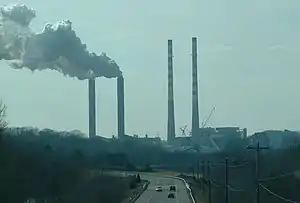Cumberland Fossil Plant
Cumberland Fossil Plant is a pulverized coal-fired power station located west of Cumberland City, Tennessee, USA, on the south bank of Lake Barkley on the Cumberland River. Owned and operated by Tennessee Valley Authority (TVA), it has a gross capacity of 2,470 MW,[1] and is the most powerful power station in Tennessee.[2]
| Cumberland Fossil Plant | |
|---|---|
 | |

| |
| Country | United States |
| Location | Cumberland City, Tennessee |
| Coordinates | 36°23′29″N 87°39′17″W |
| Status | Operational |
| Commission date | 1973 |
| Owner(s) | Tennessee Valley Authority |
| Thermal power station | |
| Primary fuel | Bituminous coal (pulverized) |
| Power generation | |
| Nameplate capacity | 2,470 MW |
Description
Commissioned in 1968, the Cumberland Fossil Plant contains two identical units, rated at 1.235 GWe gross each, Units 1 and 2 were launched into service in March and November 1973, respectively.[3] In 2004, the two units accounted for almost 12% of TVA's total electricity generation.[2] As of the mid 2010s, however, TVA's Sequoyah Nuclear Plant near Soddy Daisy, Tennessee, with a slightly lower capacity, was generating more power.[4]
The Cumberland Fossil Plant has two of the tallest chimneys in the world at 1,001 feet (305 m), built in 1970. These chimneys are no longer in use, having been replaced with smaller chimneys connected to the scrubbers.
Bituminous coal is delivered by barges along the Cumberland River waterway. The plant consumes about 20,000 tons of coal a day.[2] All of the waste heat is dumped into Cumberland River water.
Pollution and releases into environment
| Pollutant | Air | Water | Land | Offsite disposal | Total |
|---|---|---|---|---|---|
| Antimony compounds | 39 | 178 | 8,947 | 0 | 9,164 |
| Arsenic compounds | 182 | 119 | 46,096 | 0 | 46,397 |
| Barium compounds | 142 | 0 | 279,200 | 25 | 279,367 |
| Beryllium compounds | 10 | 0 | 9,952 | 1 | 9,963 |
| Cadmium compounds | |||||
| Chromium compounds | 368 | 142 | 87,420 | 7 | 87,937 |
| Cobalt compounds | 63 | 89 | 19,887 | 1 | 20,040 |
| Copper compounds | 286 | 6,798 | 64,120 | 3 | 71,207 |
| Lead compounds | 253 | 0 | 59,122 | 3 | 59,378 |
| Manganese compounds | 558 | 33,864 | 177,130 | 18 | 211,570 |
| Mercury compounds | 240 | 0 | 346 | 0 | 586 |
| Nickel compounds | 516 | 2,504 | 98,180 | 6 | 101,206 |
| Selenium compounds | 2,501 | 2,075 | 6,573 | 0 | 11,149 |
| Silver compounds | |||||
| Thallium compounds | 36 | 0 | 30,200 | 2 | 30,239 |
| Vanadium compounds | 290 | 0 | 191,560 | 13 | 191,864 |
| Zinc compounds | 2,006 | 2,447 | 248,070 | 12 | 252,534 |
| Hydrochloric acid (aerosol) | 340,006 | 0 | 0 | 0 | 340,006 |
| Hydrogen fluoride | 72,006 | 0 | 0 | 0 | 72,006 |
| Sulfuric acid (aerosol) | 8,793,606 | 0 | 0 | 0 | 8,793,606 |
| Benzo(g,h,i)perylene | 0.21 | 0 | 0.65 | 0 | 0.87 |
| Dioxins | 0.008 | 0 | 0 | 0 | 0.008 |
| Polycyclic aromatic compounds | 49.8 | 0 | 59.2 | 0.0 | 109.0 |
| Naphthalene | 100 | 0 | 0 | 0 | 100 |
| Ammonia | 3,640 | 316 | 0 | 0 | 3,956 |
| Nitrate compounds | 0 | 128,879 | 0 | 0 | 132,407 |
Environmental protection measures
To reduce sulfur dioxide (SO2) emissions, both units at Cumberland use wet limestone scrubbers. To reduce nitrogen oxides (NOx), the units use low-NOx burners as well as selective catalytic reduction systems, which were completed in 2004.[2]
See also
- List of power stations in Tennessee
- List of the largest coal power stations in the United States
References
- https://www.tva.gov/Energy/Our-Power-System/Coal/Cumberland-Fossil-Plant
- "Cumberland Fossil Plant". Tennessee Valley Authority. Archived from the original on 2008-09-16. Retrieved 2008-07-18.
- "Existing Electric Generating Units in the United States, 2006" (Excel). Energy Information Administration, U.S. Department of Energy. 2006. Retrieved 2008-07-14.
- "Tennessee - State Energy Profile". eia.gov. U.S. Energy Information Administration. May 17, 2018. Retrieved 2018-11-02.
- "Cumberland Fossil Plant, Emissions". Tennessee Valley Authority. Retrieved 2008-07-18.